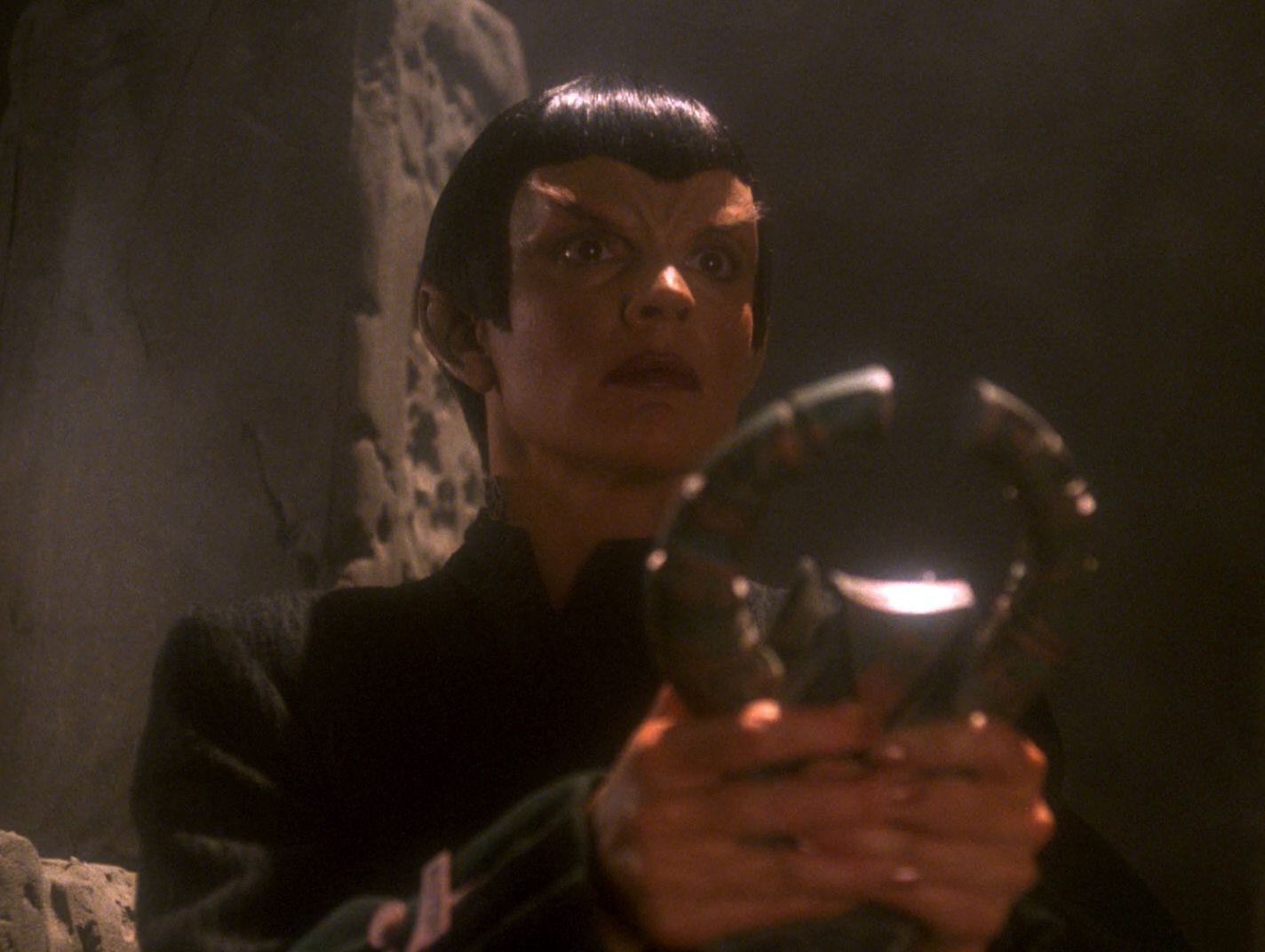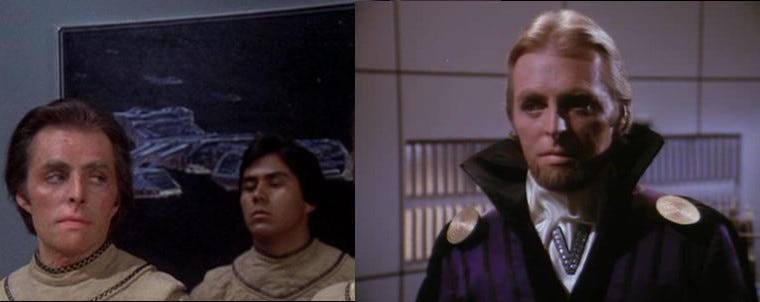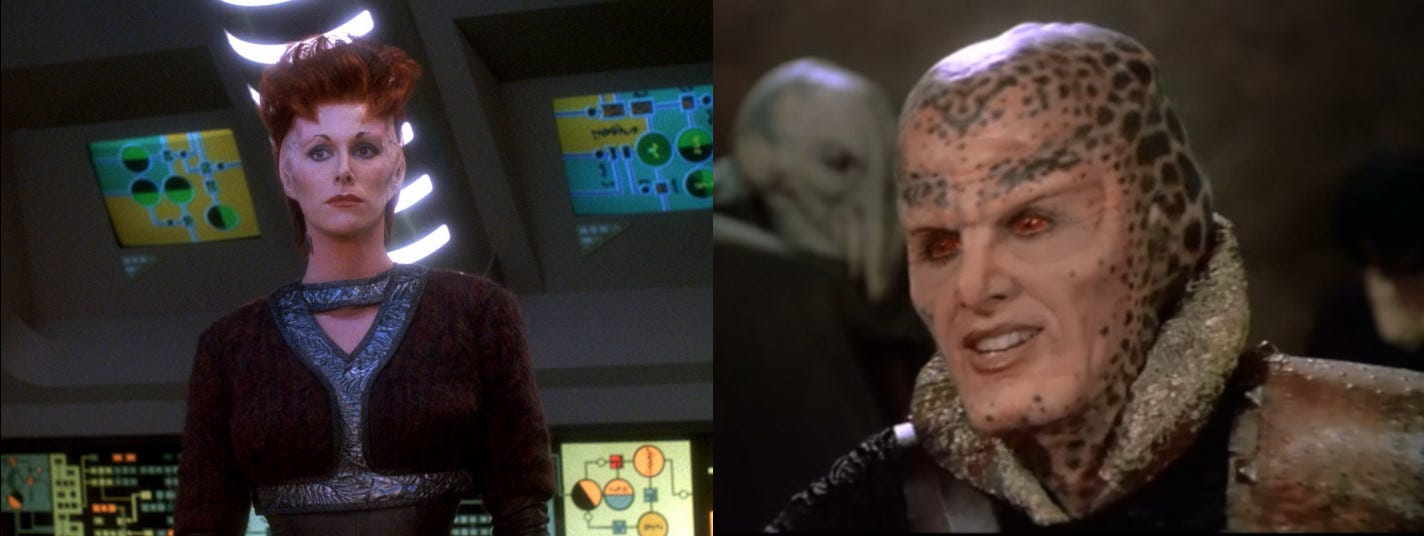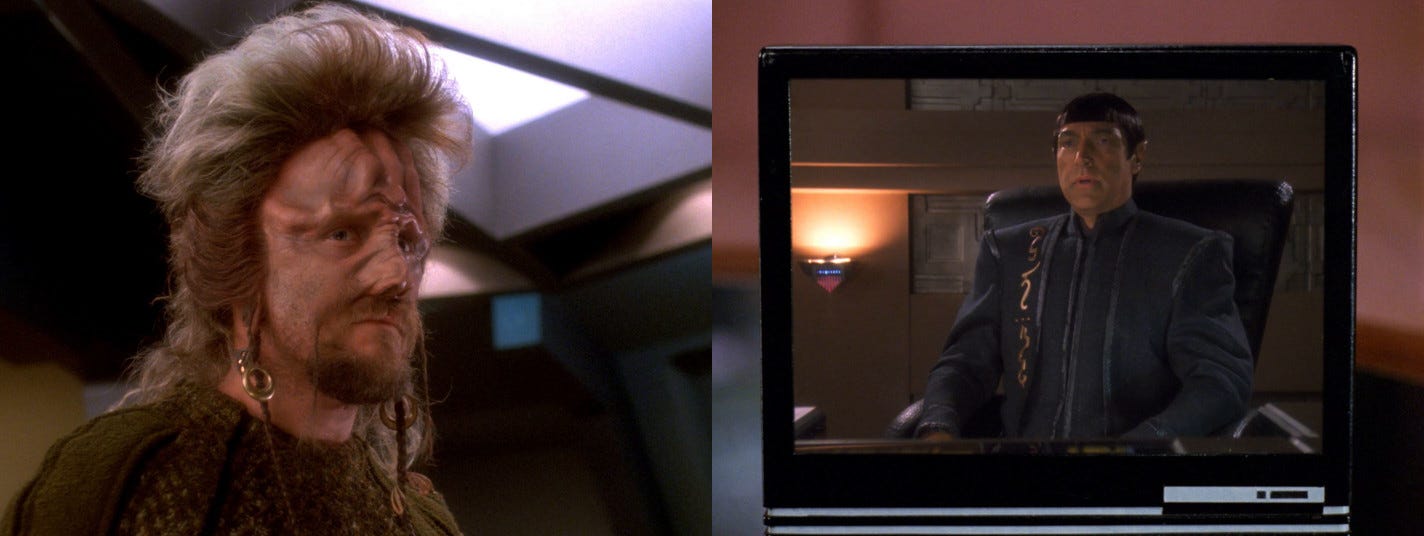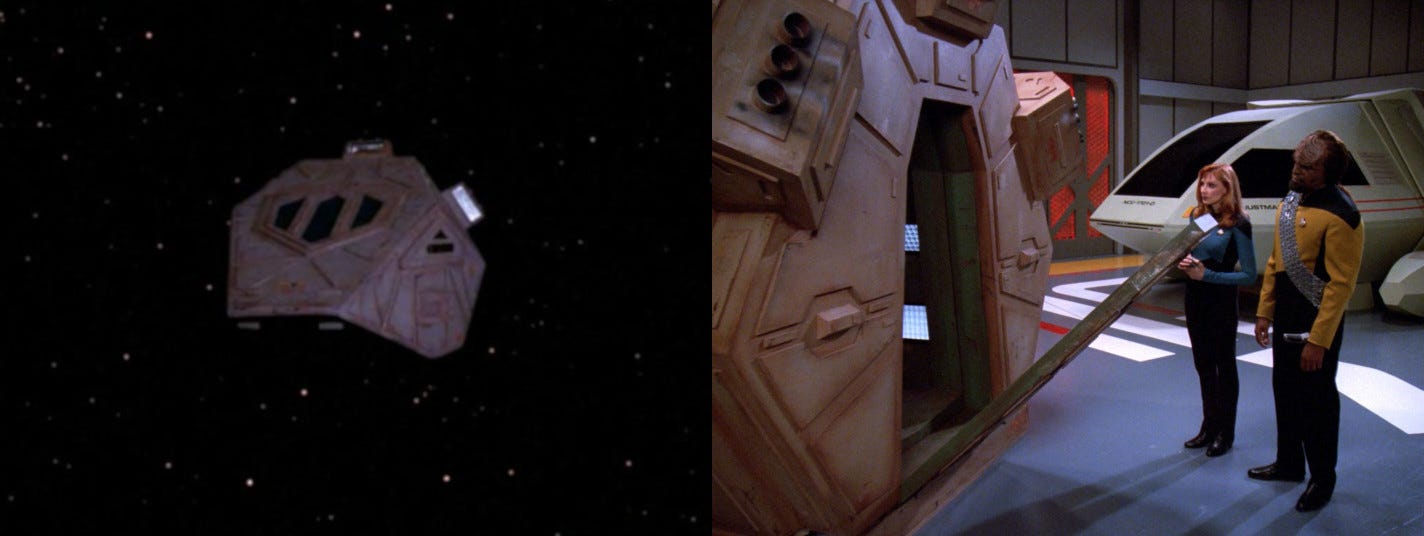Gambit, Part II
Okay, so it's Space Pirates, but also Vulcan Isolationists. Not sure if that's better or worse.
The Enterprise-D plays possum after being shot with weapons purposefully sabotaged to be low power. It’s a gambit, see, like the title! Off the unnamed Pirate Ship zooms, with further intrigue aboard between the crew as Picard and Riker continue to pretend to be enemies - another gambit, just like the title! Meanwhile, Data chews out his first officer, Worf, for being snippy with him. This isn’t a gambit. But we discover on the Pirate Ship that the Romulan Pirate is actually a member of the Vulcan security service - more gambits! Back on the Enterprise, Worf contrives a health and safety inspection as an excuse to search a Klingon shuttle - yet more gambits! Then the Space Pirates beam over to the Enterprise to capture the Klingon - gambits upon gambits! And the secret Vulcan goodie is secretly actually the baddie! How many more gambits can we stand?!
Words
So we started out with Space Pirates, and now we get Vulcan Isolationists, and we finally get to the MacGuffin, which is a ‘psionic resonator’. This part of the plot came from the writer credited for Part I’s teleplay, Naren Shankar. He was inspired by Spock’s admission in the classic Trek episode “Journey To Babel” that a Vulcan was permitted to kill for a logical reason. This gave him a twist on your common or garden Vulcans:
We went for people who very logically felt that Vulcan’s problems were linked to contamination by illogical people, so in a logical sense you say ‘Get rid of them’… a very logical way to arrive at racism.
Apparently, Shankar originally proposed that the Vulcan Isolationist Movement were going to literally phase Vulcan out of the universe to avoid getting culturally contaminated by other species. This was not popular, as Shankar recalled!
Everyone was afraid it was going to be like a Space: 1999 episode. The notion was to dimensionally shift the planet so you couldn’t get to them. In that sense, it would be pure isolation. I still think that’s a cool idea. Nobody else does, however.
Hey, don’t knock Space: 1999, Shankar! Anyway, having dragged the story up the first side of the mountain, Shankar handed over to Ronald D. Moore who was supposed to inject some energy into the trip down the other side. What did he make of his task?
I felt we ran out of story in ‘Part II’. There were places where I was treading water. We had to find the Lost Ark and I didn’t know what the Lost Ark was. Instead, we had a device from ancient Vulcan myth that had mythic properties that you explain are telepathic focusing properties. I was trying really hard to make this thing work and in the end, I just said, “All right, maybe we should just go for it and make this a classic Gene Roddenberry kind of message and go for ‘think happy thoughts’ and make it something which tied into the backstory of Vulcan and of Surak and peace.” I thought it would fit in nicely. I’m not sure if it did. It might have just fallen in on its own gooeyness.
With a bit of digging, I’ve unearthed claims that Moore entertained himself (and Shankar) by making references to classic Trek in the planets. There’s ‘Yadalla Prime’, which allegedly references Yonada in “For the World is Hollow and I Have Touched the Sky”, ‘Barradas III’ is tweaked from Beratis, which is one of Redjac’s names in “Wolf in the Fold”, while the ‘Stone of Gol’ is named after the plateau where Spock is seen in Star Trek: The Motion Picture. Shankar joked that the weapon should be called the “Gol Stone” (groan!).
In the wider mythos, this episode is the first to confirm that Vulcan was one of the founding worlds of the Federation, which is used to great effect in Star Trek: First Contact.
Acting Roles
I must confess that until writing these WAMs I completely missed the significance of Robin Curtis appearing in “Gambit”! She gives solid performances both as fake Romulan Tallera and actual Vulcan Isolationist T’Paal, the true villain behind it all (okay, same character in this case, but still slightly different roles!). Curtis, of course, was the replacement Saavik in Star Trek III: The Search for Spock, when Kirstie Alley inexplicably developed a career and wouldn’t come back to reprise the role.
Having established a name for herself playing Vulcans, we can scarcely be surprised that she appears here as - gasp! - a Vulcan. However, she is now a Vulcan with conventional Vulcan/Romulan hair. What happened to the awesome hair Vulcans had in the 23rd century?! Now they’re all dull pudding bowls. I mean look at this side-by-side comparison:
Casting Curtis in “Gambit” was the end of a long, long struggle to find a place for Curtis in TNG. Back in the second season, they had invited her to play K’Ehleyr in “The Emissary”, but she was busy filming something else. That’s the official story anyway. In 1989, her sole other credit is for a single episode of Night Court, so it would take an enormous coincidence for that story to be true.
Likewise, they offered her the lead villain role of Kelsey in “Starship Mine”, and she had to turn it down as she’d apparently accepted another role just half an hour earlier. But as I mentioned in that WAM, she only had one role that year too. So I find this all a trifle suspicious, and wonder if the truth of the matter isn’t that Curtis was deathly afraid of coming back to Star Trek, perhaps for the usual reason that she feared being typecast. Curtis’ career is just not busy enough for these two coincidental casting clashes to be entirely plausible, but maybe I’m just being Mr Suspicious Pants.
The other big casting for this two-parter is Richard Lynch as Arctus Baran.
Jeri Taylor said of this:
Richard was simply the best person who read for the part. Peter Lauritson who directed the first episode, knew his work, liked him, and really wanted him. It’s always a problem to find worthy adversaries for Picard. You need an actor who has the power, stature, and presence to go toe to toe with him and if you don’t have that, you don’t have an episode. Richard brought all of this and for all his campiness and the sort of stereotypical things he has done, he has that undeniable power and I thought it was a good trade.
What sort of stereotypical roles is Taylor talking about? Why, classics like the brutal enforcer Ankar Moor in 1978’s Deathsport, or the ruthless silly-named tyrant Titus Cromwell in 1982’s The Sword and the Sorcerer - and who could forget the villainous Soviet spy Rostov in the 1985 Chuck Norris vehicle Invasion U.S.A.! Yes, over a hundred and sixty roles of pure unadulterated cheese fill up Lynch’s super-stuffed career sandwich. TV highlights include the gruff and untrustworthy Wolfe in the 1978 Battlestar Galactica story “The Gun on Ice Planet Zero” (below left), and the crime lord Morgan Velosi in the 1979 Buck Rogers in the Twenty Fifth Century story “Vegas in Space” (below right).
Look at that scowl - that’s a grimace you could build a career upon! So awesome is Lynch’s filmography that I will never again undervalue his appearance in “Gambit”, a two-parter which is infinitely elevated by having such an unbelievably awesome shlockmeister in its cast!
Filling out the Pirate Ship ‘Model Borrowed from DS9’ is Vekor, played by Caitlin Brown (later: Julie Caitlin Brown). She was also borrowed from DS9, having appeared seven months earlier in “The Passenger”. You could almost not notice Brown’s Vekor here if not for the striking make up (below left), so it’s unfortunate for her that “Gambit” is so stuffed with great alien make-up that she barely warrants a nod.
Having proven her willingness to sit in the make-up chair for dozens of hours for just a few scenes, however, she landed the recurring role of the Narn diplomatic attaché Na’Toth in Babylon 5 (above right), her only recurring role of note unless you count her five appearances in US daytime soap All My Children very early in her career.
Finally, Cameron Thor plays Narik (below left), who also gets to be killed by Robin Curtis’ T'Paal. Believe it or not, Thor has had a decent career as roughly half of his thirty-odd roles have been in movies (not the norm for jobbing actor). Look out for him next time you weep for the lack of stop motion dinosaurs in 1993’s Jurassic Park: he’s the guy from the rival biotech firm who bribes Wayne Knight’s character to give up dino-trade secrets.
Also, a huge shout out to Martin Goslin’s Satok (according to the screenplay) or Setok (according to the closing credits). I draw attention to Goslin (above right) not because his performance here as a forgettable Vulcan government official is in any way interesting, but because his tiny run of ten roles culminates in 1994 with a role as a Matre D’ in L.A. Law - his very next role after appearing in this episode! Combined with Bruce Gray in “Gambit, Part I” and we have another perfect example of the long running TNG-L.A. Law exchange programme that I won’t shut up about.
There’s also enormous fun to be had with NBA star James Worthy, playing the taciturn Klingon Koral.
This came about thanks to a chance meeting between Worthy and Robert O’Reilly (Gowron), who were sat next to each other on an airplane (I’m guessing they were flying first class…). Worthy confessed he loved the show, and so at O’Reilly’s behest the basketball player met with Rick Berman and Michael Piller, who handed him over to Jeri Taylor to look for a cameo opportunity. Since Ronald D. Moore was circling the drain trying to fill in the blanks for this episode, ‘Koral’ was created to eat up time - and he’s wonderfully entertaining here. I love that they make his lack of acting skill an asset by giving him a role that requires him to do basically nothing!
Models, Make-up, and Mattes
This episode sees the sixth and final appearance of the studio miniature created for the Nenebek back in “Final Mission”, here appearing as a ‘Toron-class shuttlecraft’ according to the screenplay and on-screen dialogue. Farewell Nenebek! You’ve done yeoman service to TNG and we’ll never forget you.
The prop for this Vulcan artefact has an amusing backstory.
Apparently, the Vulcan god of death on the right was originally bald - but Rick Berman gave instructions to etch hair on it, because he felt it looked too much like Patrick Stewart in close up!
All in all, despite all the writers’ complaints, there’s a lot of swashbuckling fun in this two-parter, which I thoroughly enjoyed revisiting.



